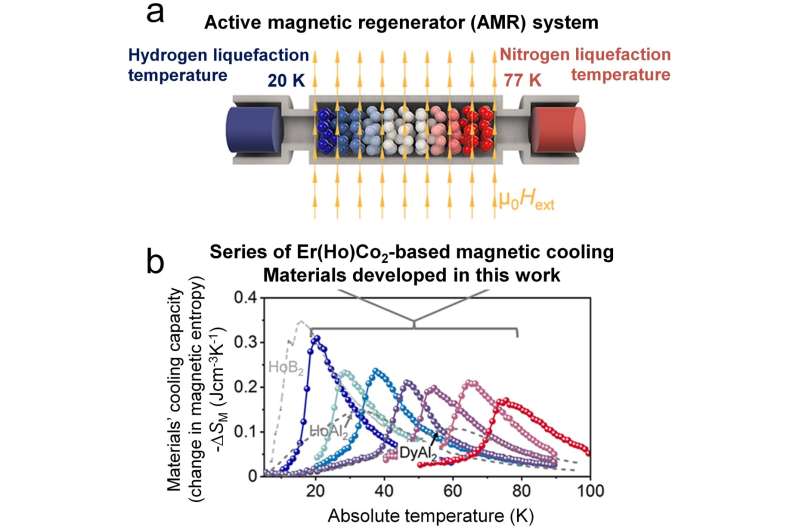A series of Er(Ho)Co2-based compounds developed that can be used in combination to effectively cool hydrogen from 77 K to 20 K: its liquefaction temperature. Credit: Sepehri Amin HosseinNational Institute for Materials Science
National Institute for Materials Science (NIMS), Tohoku University and Japan Synchrotron Radiation Research Institute (JASRI) have developed a series of Er(Ho)Co2-based magnetic cooling alloys that can be used to efficiently cool hydrogen from 77 K to 20 K: its liquefaction temperature. These alloys show excellent cyclic durability and can be used to develop a high performance magnetic refrigeration system capable of low-cost hydrogen liquefaction—a key technology in achieving widespread use of the green fuel.
Hydrogen fuel is expected to play an important role in promoting carbon neutral society. Hydrogen gas has large volume and its liquefaction has great advantages in terms of safety and saving space for storage and transportation. Widespread use of hydrogen will require the development of new technologies enabling production of liquid hydrogen at substantially lower cost. Magnetic refrigeration technology exploits changes in magnetic entropy in a magnetic material in response to cyclic application and removal of an external magnetic field. Removal of the magnetic field causes the magnetic moments of atoms in the material to change from aligned orientations to random orientations. This in turn causes the material to absorb heat from a refrigerant gas surrounding it, indirectly cooling and liquefying hydrogen. In theory, magnetic refrigeration technology can be 25% to more than 50% more energy-efficient than the conventional vapor compression refrigeration technology. In addition, the size of the needed equipment can be much smaller as it does not require a large compressor—a major energy consumer—potentially reducing liquid hydrogen production cost significantly. However, no existing magnetic material was able to efficiently cool hydrogen across a wide temperature range from 77 K (nitrogen liquefaction temperature) to 20 K (hydrogen liquefaction temperature) and withstand the deterioration caused by accumulated internal stress resulting from exposure to changing magnetic fields and temperatures.
Er(Ho)Co2-based magnetic compounds had been known to be effective in cooling hydrogen from 77 K to 20 K. However, their cooling capability was not reversible due to their poor cyclic performance. These problems are overcome in this work. This research group discovered that by adding trace amounts of 3d transition metal elements make the compounds resistant to deterioration caused by repeated magnetic field application and temperature fluctuation. By adjusting the types and amounts of these additives, the group was able to develop a series of magnetic materials that can be used in combination to cool hydrogen from 77 K to 20 K without compromising their high cooling capabilities across this temperature range.
More information: Xin Tang et al, Magnetic refrigeration material operating at a full temperature range required for hydrogen liquefaction, Nature Communications (2022). DOI: 10.1038/s41467-022-29340-2
Journal information: Nature Communications
Provided by National Institute for Materials Science
























